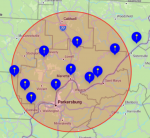I think you are misconstruing terms. There are standalone sites (the majority) -- single sites (which Motorola refers to as ASRs) with a set of different frequencies per each site. Then there are simulcast "cells" like Washington County that are made up of multiple physical sites in various locations within the intended coverage area, all of which use the same single set of frequencies and that are time synced to transmit at precisely the same time on the same frequency(s). If you look at the attached picture (forget about the fact that one site is outside of the circle). The "cell" here is a coverage cell. The individual sites within a simulcast cell are located in certain geographic locations to ensure proper coverage within that cell.
So if you are using a scanner and it stops on a particular talkgroup being transmitted on the Washington Co Simulcast, and your scanner shows that the active frequency transmitting that talkgroup is 773.38125, then in reality there are numerous sites within the county transmitting at the same time on 773.38125 to deliver that audio countywide.
The Washington Co simulcast consists of 11 separate sites that are within a single "cell", sharing all of the same frequencies and transmitting all information at the same time on whatever frequencies are active.
It has nothing to do with using cell[ular] towers. Some tower locations within the simulcast cell might actually have cellular company equipment on them, but if they do it's just a coincidence because the system doesn't rely upon the existence of cellular telephone equipment to function.
Simulcast is an abbreviation for simultaneous broadcast, and in the context of land mobile radio, it means simultaneous transmission from two or more repeater sites on the same radio frequency and with the same modulation.
urgentcomm.com



